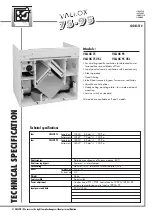
L&L VENT-SURE DOWNDRAFT KILN VENT INSTRUCTIONS
ventsure-instruct.pdf
REV: 8/1/2017
Page 8
©
2017
L&L Kiln Mfg, Inc. 505 Sharptown Rd, Swedesboro NJ 08085 856.294.0077 F:856.294.0070 [email protected] hotkilns.com
How do I determine the size, number, and
location of holes in the top and bottom of
the kiln?
As a general rule, you should have one 1/4 inch hole for
every 4 cubic feet of kiln volume. The holes are normally
placed within a 4 inch circle in the center of the kiln floor.
Please see our hole chart on page 7. L&L does not normally
recommend drilling holes in the top except for certain
instances where airflow needs to be increased such as for
glazes which need an oxygen rich environment.
Will the fumes coming through the vent
damage my plants, the neighborhood pets
or disturb the local environment?
For the most part, the fumes have been diluted enough
already when they are exhausted, however that depends
on how you have your bypass box setup. We do not
recommend placing the outlet of the vent below an open
window and we have heard of plants near the vent outlet
being affected by the vent fumes so keep this in mind
when locating vent outlet. Once the fumes are exhausted,
they will quickly be diluted by the outside air, so it is only
the immediate area around the vent that you need be
concerned about.
Will using the vent cause my firing to take
longer?
Generally only a little bit longer. The vent system removes
only a small amount of heat from the kiln due to the physics
of how thin air gets at very high temperatures. (L&L NOTE:
We have seen vents overpower smaller kilns - so it is
important to adjust the amount of venting in some cases.
On the other hand an example of an e23T 7 cubic foot kiln
firing an 85 pound load on Fast Glaze program to cone 8
took 7 hours and 4 minutes with a vent on and 6 hours and
24 minutes without a vent. The vent was on the whole time).
What does it cost to operate the vent system?
The vent system should likely cost less than 1 cent/hour to
operate (electricity costs). Downdraft vents are still vastly
more efficient than hoods which remove tons of air from
the kiln room while the Vent-Sure only removes a small
amount of air from the kiln. (It does cost more to run the
vent because it does take heat out of the kiln. For example
an e23T 7 cubic foot kiln firing an 85 pound load on Fast
Glaze program to cone 8 took 70 KW hours with a vent on
and 62 KW hours without a vent. At 8 cents per KW hour
that would be a cost of $0.64 more for the firing. The vent
was on the whole time).
Will the cold air entering the kiln damage the
product?
No. The amount of air coming in is too small unless you drill
holes in the lid, which is not normally recommended. The
air coming in is also distributed throughout the kiln evenly.
Will faster cooling crack the ware if I leave
the vent on during the cooling Cycle?
No. Most kilns will cool faster with the vent system, but it
is achieved at such an even rate and distribution that there
would not be any damage to ware. (L&L NOTE: The vent
will remove more molecules of air and hence heat as the
kiln cools. This is because the density of the air increases
the lower in temperature you go. This is one reason why
kiln vents are so efficient - they don’t remove too much heat
when you don’t want them too at the higher temperatures).
What should I do if I still smell fumes?
Check all ductwork for leaks and see our comments on
“Adjusting the Bypass System”.
If using a hood type vent (like the Vent-a-Kiln) do
you need a kiln vent (like the Vent-Sure) also?
You need to vent fumes from the kiln and the room and heat
from the room. You must have ambient ventilation in a small
room for heat and to remove fumes that may not be fully
removed by the kiln vent. If you have a very large room that
can dissipate heat and trace fumes than you may not need
ambient ventilation.
The Vent-Sure is designed to remove fumes that are
generated in the kiln from the kiln and therefore from the
room. The Vent-Sure downdraft kiln vent does not remove
enough heat from a small room to be used for ambient
ventilation.
If you have a good overhead vent hood you may discharge
the output of the Vent-Sure into that hood.
At what temperature should you turn off the
Vent-Sure kiln vent?
A customer writes: When firing glazes what is a good temp
to turn off the vent so kiln can hit target temp in my case
2190 Deg F. Do glazes off-gas after say 2000 degrees? Is
there a general temperature to turn off vent?
Answer: Generally speaking it is best for your kiln to leave
the Vent-Sure on for the entire time the kiln is heating up.
Mostly this is to get all of the corrosive fumes before they
get to your elements, wiring, and other metal parts of the
kiln.
You can leave it on for the cooling as well if you need it to
cool off more quickly.





























